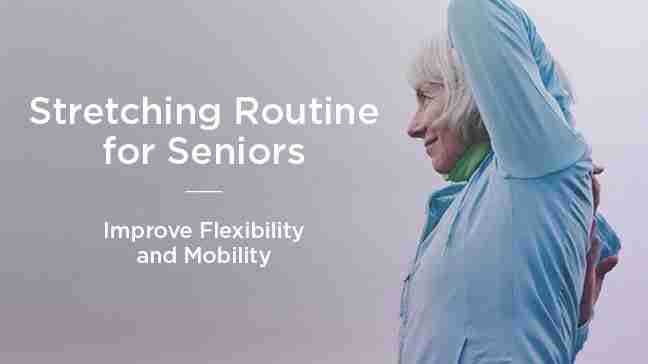It’s common knowledge that people slow down as they age.
Daily activities like standing up from a chair and getting in and out of bed become increasingly difficult. These limitations are often caused by a decline in muscle strength and flexibility.
Flexibility is the ability of the muscles and tendons to lengthen and stretch in response to movement and allow a joint to move through its range of motion. A good stretching program is important to incorporate into your daily routine to help maintain flexibility.
Stretches for the neck, arms, back, hips, and legs will help maintain flexibility as the years pass by, keeping you limber for all life has to offer.
Stretching allows for greater movement in joints and improves posture. It also helps to release muscle tension and soreness, and reduces the risk of injury. Lastly, it may also help increase circulation, muscle control, and improve balance and coordination.
A study published in the Journal of Gerontology looked at the 12-month results of a stretch and flex program for older adults. The participants demonstrated positive changes in areas like physical fitness, self-efficacy, perceived functioning, and well-being. They also experienced a decrease in pain.
Seniors should try to stretch major muscles groups for at least 10 minutes, two days a week.
Perform flexibility exercises on all days that cardiovascular or resistance training exercise occurs, if possible.
- Take a deep breath and slowly exhale as your stretch.
- Hold each stretch for 30 seconds to give the muscle ample time to relax.
- Don’t bounce while you stretch, as this increases your risk of injury.
- Only stretch until you feel tension in the muscle, not to the point of pain.
- Always warm up before stretching by moving around for 5 to 10 minutes, such as going for a walk.
The National Institutes of Health recommend including some of these stretches in your fitness routine.
Maintaining mobility of the neck is important for posture and activities such as driving.
- Stretch the neck by slowly bringing your chin toward your chest and turning your head side to side.
- Hold each position for 15 seconds.
Shoulder mobility is important as you age to maintain independence in activities such as getting dressed or getting items off a shelf.
- Stretch your shoulders and arms by holding a towel in one hand over your head and letting it drape down behind your head and back.
- Grab the other end of the towel with your other hand and gently pull down until you feel a stretch.
Poor posture often causes the muscles of the chest to become tight. Proper stretching can help lengthen these muscles, assisting with posture.
- Stretch your chest by extending both arms to the side, palms facing forward.
- Reach back with your hands until you feel a stretch across your chest and front of your arms. If you have a hard time holding your arms up, use a wall. Put your hand on a wall and step forward until you feel a gentle stretch in your chest. Switch to the other side. Do not overstretch.
Ankle stiffness is often a cause of poor balance. Maintaining ankle flexibility is important for activities such as walking and getting up and down.
- Stretch your ankles by sitting in a chair and slowly moving your foot up and down and side to side.
- Hold each position 30 seconds and repeat on other foot.
Tight hamstrings, the muscles on the back of your thigh, can contribute to low back pain and difficulty walking.
- Lie on your back and extend one leg perpendicular to your body.
- Grasping around the back of your thigh, slowly pull the leg towards you, keeping your other leg and hip on the ground. Do not pull on your knee when stretching.
Your quadriceps, the large muscles on the front of the thigh, are important muscles for walking and standing.
- Start by lying on your side and bending your knee, bringing your foot behind you.
- Pull your foot towards your body until you feel a stretch. You can use a belt or a towel to help if you cannot reach your foot, and this can be done in a standing position as well.
Older adults — especially women — sometimes have a lot of tension in their hips.
- Stretch your hips by lying on your back, bringing one knee out to the side of your body.
- Rest your foot against your opposite leg and gently push down on the bent knee until you feel a stretch.
Maintaining mobility in the spine is important for proper posture.
- Stretch your lower back by lying on your back, knees bent and feet together. Keep feet flat on the floor.
- Keeping knees together, lower your legs to one side, twisting your torso until you feel a stretch. Hold and repeat on other side.
Always consult a doctor before starting a new exercise routine. If you have any muscle or joint injuries or previous surgeries, be sure to ask your doctor or physical therapist what stretches are best for you.
Never stretch to the point of pain or hold your breath during stretches.
Stretching has many benefits for older adults. Stretching is convenient, requires minimal equipment, and can be done anywhere.
By incorporating a stretching program into your week, you may benefit from increased flexibility, relaxation, and an improved quality of life.




